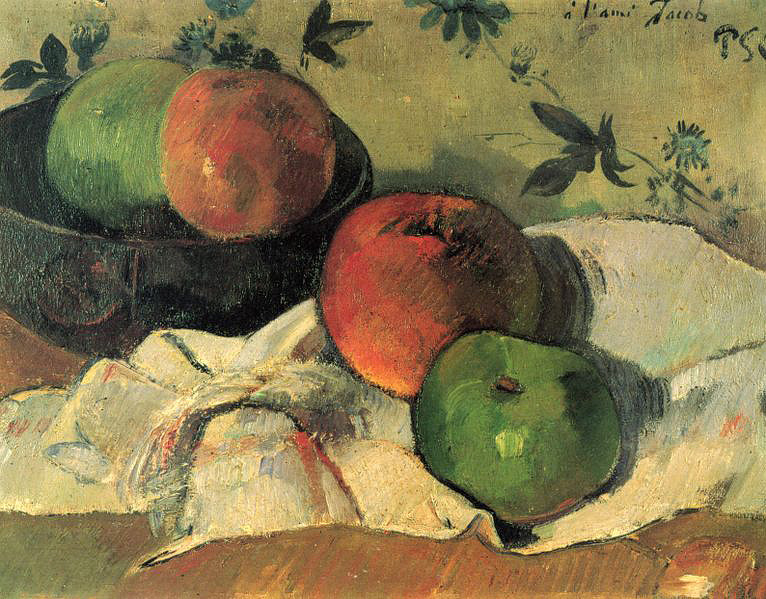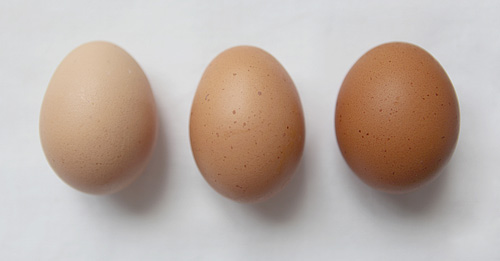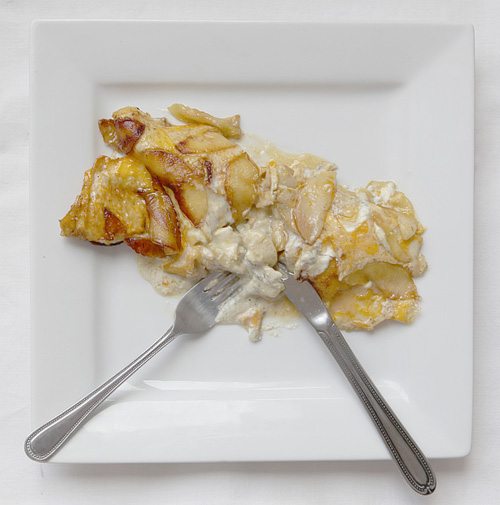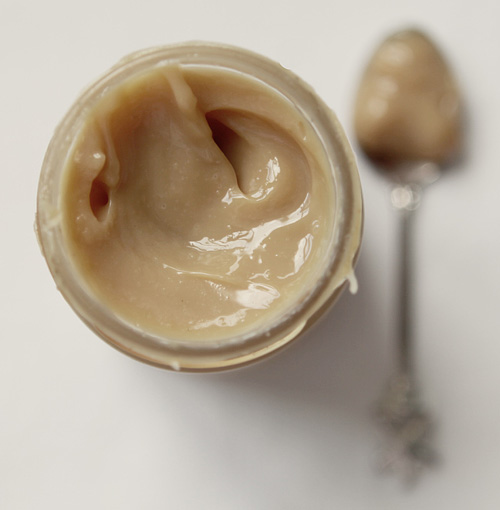
Paul Gauguin (full name Eugène Henri Paul Gauguin) was a Post-Impressionist painter whose art heralded the return to the pastoral (idealized landscapes) and Primitivism. He was a major influence in the development of Modern art with his bold colours and design oriented paintings. His travels in Central America impacted his work as he incorporated the symbolic depth, exaggerated body proportions, and stark contrasts of the ‘native’ art he encountered. He abandoned traditional European painting and focused on pure colours separated by thick black outlines (1). Gauguin owned a still life by Paul Cezanne and he seemed to emulate characteristics of Cezanne’s art in the painting above. The round circular forms of the apples and the black bowl do not correlate with regard to the perspective in the picture plane and the wildness of Cezanne’s brush mark is also found in Gauguin’s handling of paint on the tablecloth.

An omelet is a beaten egg that is cooked in a frying pan in butter (or oil) with some sort of filling whether it be cheese, meat, or vegetables. The top side of the omelet is not cooked prior to folding it into a trifold design. They are thought to have originated in Ancient Persia before travelling to Europe to become a frittata, tortilla, and omelette in Italy, Spain, and France respectively. In 2002 the largest omelet in the world was made in Ontario, Canada which weighed 2.95 tons (2).

Dulce de leche, sometimes known as milk jam, is prepared by slowly heating sweetened milk to create a thick sauce that tastes similar to caramel. It is found all over Latin America and there is a similar version from France called confiture de lait. Up until 1984 when the company went out of business, there was a solid candy made of dulce de leche in Argentina called Vaquita “little cow”. It has been gaining recoginition recently because of its use in commercial foodstuffs including Häagen-Dazs, Starbucks, and in dulce de leche flavored Girl Scout Cookies (which I have yet to try, they were only introduced this year) (3).

Caramelized Apple Omelet
adapted from Gourmet
serves 2
2 TB butter
2 tsp sugar
1 apple, peeled, cored, and cut into slices
3 eggs
2 TB sour cream
2 TB dulce de leche
2 TB goats cheese
Melt butter in a skillet over medium heat. Add sugar and cook stirring until dissolved. Add apple and cook turning the slices once until golden and tender.
Whisk together the eggs with a pinch of sea salt. Add the eggs to the apples in the skillet and cook over a medium-low heat, lifting the edges of the omelet so the raw egg can flow below. Cook about two minutes until the omelet is set on top but still most. Dollop the sour cream, goats cheese and dulce de leche across the center of the omelet.
Fold the bottom third of the omelet over the filling and holding the skillet over a plate carefully slide the omelet out and fold the last third over the filling. Cut in half and divide between 2 plates.

Dulce de Leche
1 can (400g/14oz) sweetened condensed milk
Pour one can of sweetened condensed milk into a shallow pie dish and sprinkle a bit of salt on the top.
Set the dish in a water bath in a roasting pan with the water rising about half way up the sides of the pie dish.
Cover the pie plate with aluminum foil and bake about an hour in an oven at 425F (220C). Remove from the oven and whisk until smooth once cool. Store in the refrigerator and warm slightly before use.


13 comments
Lorraine @NotQuiteNigella says:
May 6, 2009
An apple omelette is certainly an intriguing idea. I’ve never seen one before but it sounds delicious, especially when dulce de leche is added ;)
Julie says:
May 7, 2009
Grandma Gene used to make her own caramel sauce too. She put the can of sweetened condensed milk into a pan with water and heated it up, but she did not open the can. The trick was to heat the contents of the can long enough and high enough to turn the milk into caramel – without it exploding. br /Please don’t try her technique…
Mallory Elise says:
May 7, 2009
how cool the concept of your blog…tres unique :P really its nice to see something different. and your shots of that pie down there are fantastic!
Philomena says:
May 7, 2009
Just discovered your blog via tastespotting, and I absolutely love it. A fabulous idea, gorgeous photographs, and exciting recipes. I’m so glad I found my way here.
Siri says:
May 7, 2009
That’s one SWEET looking omelette. Seriously, dulce de leche has never made its’ way into any of my eggs, but that doesn’t mean it never could or will. br /br /Looks like we both love photographing eggs. I love the color variation and speckling in yours.br /br /-Siri
dessert girl says:
May 7, 2009
Interesting! I’ve never heard of using caramelized apples in an omelet! Hmmm…breakfast eggs and sugar. I’m not sure how I feel about that, but you said it was delicious, so I’ll take your word for it. :-)
Angela says:
May 9, 2009
Your blog is amazing— I am so glad you commented on mine so I could discover yours!
petoskeygirl says:
May 9, 2009
can’t wait for your next creation…love this blog
Christie @ Fig amp; Cherry says:
May 10, 2009
Absolutely gorgeous! I adore home made Dulce de Leche – it’s such an easy thing to make, but such a delight.
Forager says:
May 13, 2009
I have all the ingredients at home to try this tonight – including way too many apples than I can possibly eat (I raided an apple tree and now I have to find uses for it). Thanks for the recipe!
zested says:
May 14, 2009
Wow, another combination of ingredients I never would have considered. I wonder if these flavors would work equally well in a quiche…
MonkAre says:
May 16, 2009
It’s so nice site. We love to see more on this site. Keep on updating… MonkAreRee Bali ***gjyuhgfuhtyu
Sophie says:
May 22, 2009
Very unique, I like the sound of this omelet, I’ve only had savory ones so far.